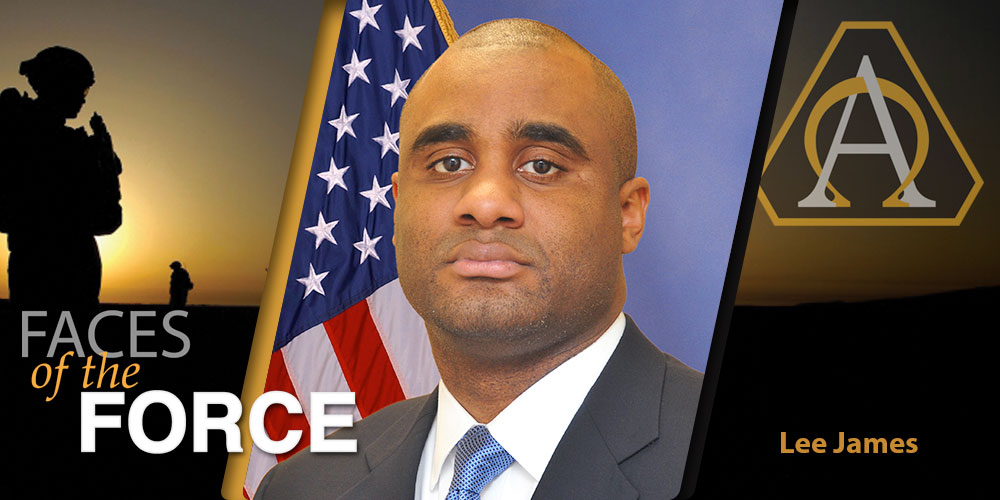
Position and Unit: Product Director, Army Human Resource Systems, Program Executive Office Enterprise Information Systems
Total Years of Service: 15
Awards: Commander’s Award for Civilian Service (2); Achievement Medal for Civilian Service; Certificate of Achievement
Education: M.S. in information resource management, Central Michigan State University; B.S. in computer science, Langston University
Lee James: Surrounded by good examples
By Susan L. Follett
Spend just a few minutes with Lee James and you’ll quickly realize that the likes his job and loves the people he works with—including past supervisors, current coworkers, former team members and the Soldiers he supports through his work as product director for Army Human Resource Systems in Program Executive Office Enterprise Information Systems (PEO EIS)
James got his start in acquisition through the Army Knowledge Leaders Program. “At the end, I was given the choice between joining the Acquisition Corps or pursuing a position on the DA staff. I chose acquisition: I liked the challenge and liked knowing that my work directly supports the warfighter.
He has since worked on an alphabet soup of projects, including PEO EIS Headquarters, PM J-AIT, PM GFEBS, PM SCES, PD FMS and now PM IPPS-A. For him, PM J-AIT— Product Manager Joint-Automatic Identification Technology—was a turning point in his career. “In addition to knowing that our work made things easier for warfighters in harm’s way, that assignment gave me a unique opportunity to work with an all-star team, that eventually spawned seven PMs, three of whom were board-selected. As a junior guy, I was very fortunate to work with them. It was a rare collection of talent that accomplished many great things for the Army and our joint forces.”
He added, “The memorable leaders I’ve worked with over the past 15 years all had one thing in common: people wanted to work for them. We’d follow them off a cliff if that’s where they led us. They all had an enthusiasm and a passion for the work we do, and they showed me the importance of relationships, discipline and consistency.”
What do you do in the Army? Why is it important?
I am the product director for Army Human Resource Systems (AHRS), responsible for the life-cycle management of the AHRS portfolio. The AHRS suite comprises four systems: the Deployed Theater Accountability System, the Electronic Military Personnel Office (EMILPO), Installation Support Modules (ISM) and Range Facility Maintenance Support System. We have also been charged to deliver the Commander’s Risk Reduction Dashboard (CRRD), which just recently received a favorable Materiel Development Decision. The CRRD will provide commanders a holistic view of their Soldiers’ high-risk behaviors, enabling them to intervene and ultimately stop those behaviors. This family of systems is instrumental in delivering interoperable human resource capabilities that improve the lives of Soldiers, commanders and human resources professionals. The Integrated Personnel and Pay System-Army (IPPS-A) will eventually subsume several AHRS capabilities (EMILPO and ISM, for example), so it’s critical that we seamlessly transition those capabilities to IPPS-A.
“…don’t forget why we do this: the people who put on the uniform every day.”
What’s the biggest challenge you face in your work?
The biggest challenge is balancing calendar-driven government processes with Soldiers who operate in an event-driven environment—ensuring that we’re getting the best technology that’s available out to the field before it becomes obsolete. I think DOD is doing a good job at overcoming that challenge by breaking down requirements into manageable increments so that we can meet needs on an evolving basis and get new capabilities out more quickly.
What has your experience been like? What has surprised you the most?
My experiences have been absolutely phenomenal. I have been pretty fortunate throughout my career to have the opportunity to work with many great organizations, under several extraordinary leaders. The learning experience has been tremendous. I have learned a great deal about communication, consistency and discipline. I have also learned a lot about the people aspect of this business. A program can have the utmost command emphasis, be fully funded and employ the most advanced technologies—nonetheless, it’s the people that make it successful. Sometimes that concept gets lost in the shuffle.
What is your greatest satisfaction in being part of the Army?
My most rewarding career experience is having the opportunity to work in a team environment. The ebbs and flows of team dynamics really move me. What intrigues me the most is witnessing a group of distinctive personalities bond together, while sacrificing our individual wants and needs, to focus on a common goal much greater than ourselves. The more I experience those moments, the more I grow to appreciate our servicemen and women (and their families), who make the ultimate sacrifice.
What advice would you give to someone who wants to be where you are?
I would give the same advice that was given to me: be yourself and don’t leave your own skin—don’t change your value base or your morals. Treat this job like a craft: learn it, master it and improve it. Finally, don’t forget why we do this: the people who put on the uniform every day.
- “Faces of the Force” is an online series highlighting members of the Army Acquisition Workforce through the power of individual stories. Profiles are produced by the U.S. Army Acquisition Support Center Communication and Support Branch, working closely with public affairs officers to feature Soldiers and Civilians currently serving in a variety of AL&T disciplines. For more information, or to nominate someone, please contact 703-805-1006.
Subscribe to Army AL&T News is the premier online news source for the Acquisition, Logistics, and Technology (AL&T) Workforce.
![]() Subscribe
Subscribe







